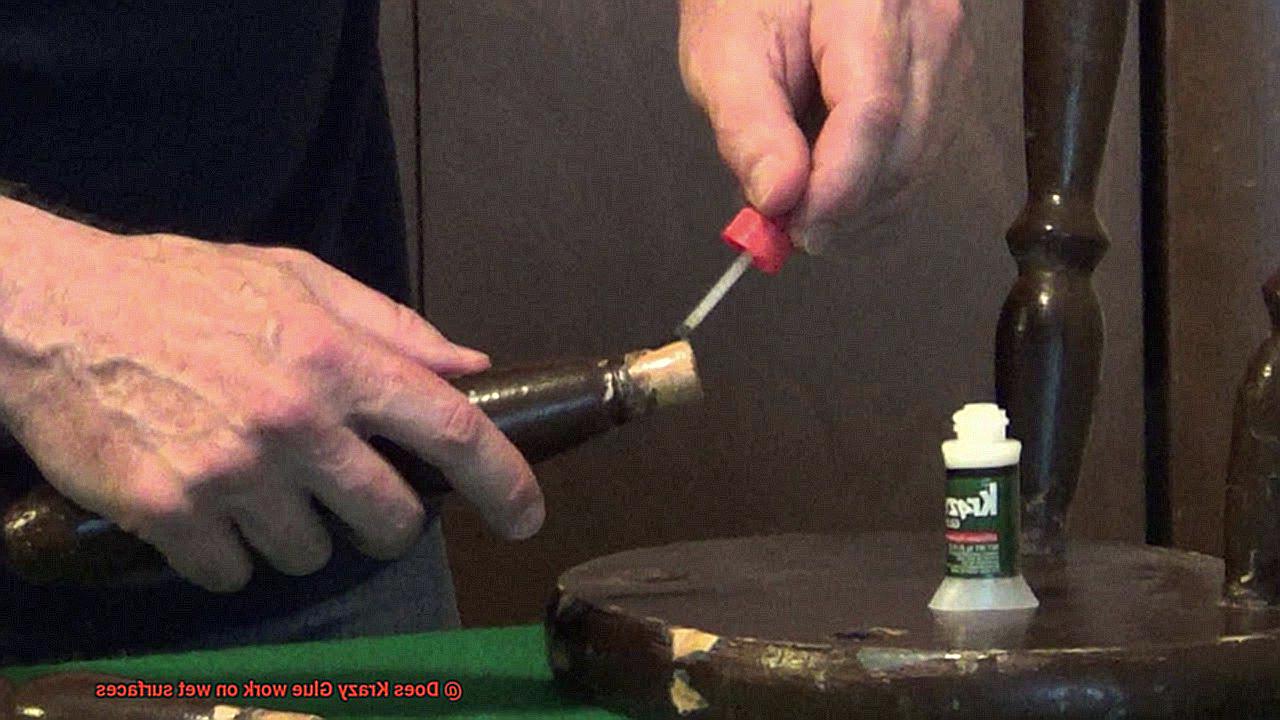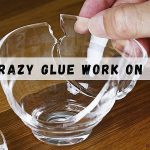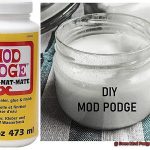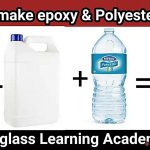Picture this: you’re caught in a torrential downpour, desperately trying to fix that broken umbrella or patch up a leaky pipe. But wait. Can Krazy Glue, our trusty adhesive sidekick, really work its magic on wet surfaces?
We’ve all heard the tales of Krazy Glue’s legendary powers, but let’s get real – can it conquer the slippery world of moisture? Join us on this wild journey as we delve into the fascinating realm of adhesives and uncover the truth about Krazy Glue’s potential to banish our wet surface woes.
In this blog post that’s equal parts informative and entertaining, we’ll unravel the science behind using Krazy Glue on damp or wet surfaces. So grab your favorite beverage, kick back, and let’s embark on an adventure to solve this sticky mystery once and for all.
Advantages of Using Krazy Glue
Contents
- 1 Advantages of Using Krazy Glue
- 1.1 Versatility: The Swiss Army Knife of Adhesives
- 1.2 Quick Bonding: Fast and Furious Repairs
- 1.3 Strong and Durable Bond: Built to Last
- 1.4 Resistance to Water: Defying the Elements
- 1.5 Easy Application: Precision at Your Fingertips
- 1.6 Clear and Invisible Bond: Beauty in Simplicity
- 1.7 Shelf Life: Ready When You Need It
- 2 Does Krazy Glue Work on Wet Surfaces?
- 3 Factors That Affect the Strength of the Bond
- 4 Tips for Successfully Using Krazy Glue on Wet Surfaces
- 4.1 Tip 1: Dry the Surface
- 4.2 When working with wet surfaces, it’s crucial to ensure that the surface is as dry as possible. Any lingering moisture can interfere with the bonding process and weaken the adhesive’s effectiveness. Take your time and be thorough when drying the surface, paying attention to any crevices or hard-to-reach areas where water may be hiding. The cleaner and drier the surface, the better chance you have of achieving a strong bond.
- 4.3 Tip 2: Apply a Small Amount of Glue
- 4.4 When working with wet surfaces, it’s best to use a smaller amount of Krazy Glue. Excessive glue can take longer to dry and may result in a weaker bond. Apply just enough glue to create a strong bond without overdoing it.
- 4.5 Tip 3: Hold Firmly for 30 Seconds
- 4.6 The key to successfully using Krazy Glue on wet surfaces is ensuring that the adhesive has enough time to fully bond with the surface. Applying pressure by holding the bonded pieces together for at least 30 seconds will help facilitate this process. Be cautious not to move or disturb the pieces during this time, as it may disrupt the bonding process. If necessary, use tape or clamps to keep the pieces in place and provide extra support while the glue dries.
- 4.7 Tip 4: Transfer Glue from Dry Surface
- 4.8 To minimize contact with moisture, apply a small amount of Krazy Glue to a dry surface nearby and then carefully transfer it to the wet surface. This technique can improve the chances of a successful bond.
- 4.9 Tip 5: Test on a Small Area First
- 5 How to Test a Small Area Before Applying Krazy Glue to a Wet Surface
- 5.1 Gathering the Materials
- 5.2 Cleaning the Surface
- 5.3 Applying the Glue
- 5.4 Observing the Results
- 5.5 Once the glue has dried, carefully observe the results. Check if it has formed a strong bond with the wet surface material and if it has maintained its adhesion over time. If the bond is strong and secure, it indicates that Krazy Glue can effectively work on wet surfaces. However, if the bond is weak or easily breaks apart, it suggests that Krazy Glue may not be suitable for bonding on wet surfaces.
- 5.6 Considering Alternatives
- 6 Different Types of Primers for Bonding to Wet Surfaces
- 7 Safety Tips for Working with Adhesives
- 8 Alternatives to Krazy Glue for Use on Wet Surfaces
- 9 Conclusion
When it comes to adhesive solutions, Krazy Glue stands out as a versatile and reliable option. Whether you’re a DIY enthusiast or simply someone who appreciates quality repairs, Krazy Glue offers a range of advantages that make it the go-to adhesive for various projects. In this blog post, we will explore the top advantages of using Krazy Glue and how it can simplify your repair tasks.
Versatility: The Swiss Army Knife of Adhesives
Krazy Glue’s versatility is truly remarkable. It can bond to a wide range of materials, including wood, metal, plastic, ceramic, rubber, and even fabrics. Say goodbye to cluttered workspaces filled with multiple adhesives – with Krazy Glue, you have one reliable adhesive that can tackle any repair job.
Quick Bonding: Fast and Furious Repairs
Why wait for hours or days for traditional glues to cure when you can have an instant bond with Krazy Glue? Its lightning-fast bonding time sets it apart from other adhesives in the market. Within seconds, you can achieve a strong bond that allows you to move forward with your projects swiftly.
Strong and Durable Bond: Built to Last
Once Krazy Glue sets, you can trust that it will hold up against everyday wear and tear. Its exceptional strength ensures that your repaired items will withstand regular use and even some level of stress or pressure. From fixing broken toys to mending jewelry, Krazy Glue provides a long-lasting solution.
Resistance to Water: Defying the Elements
Unlike many other glues that lose their effectiveness when exposed to moisture, Krazy Glue holds its ground even in wet conditions. This unique advantage makes it perfect for repairs in outdoor settings or areas prone to humidity. No need to worry about your repairs coming undone due to unexpected water exposure.
Easy Application: Precision at Your Fingertips
Krazy Glue’s user-friendly design makes application a breeze. It comes in small, convenient tubes with precision applicators, enabling controlled and precise placement of the adhesive. A little goes a long way with Krazy Glue, making it economical and efficient. Its thin consistency allows it to seep into small cracks and crevices, ensuring a thorough bond.
Clear and Invisible Bond: Beauty in Simplicity
The last thing you want after a repair is an unsightly residue or marks left behind by the adhesive. With Krazy Glue, that’s never a concern. When dried, it creates a clear and virtually invisible bond. This makes it particularly advantageous when working with transparent or light-colored materials, preserving the overall appearance of your repaired item.
Shelf Life: Ready When You Need It
There’s nothing worse than reaching for an adhesive only to find it dried out and ineffective. Thankfully, Krazy Glue stands the test of time with its impressive shelf life when stored properly. You can confidently keep a tube on hand for months or even years, knowing that it will still be ready to go whenever you need it.
Does Krazy Glue Work on Wet Surfaces?
In the realm of adhesive solutions, few products have garnered as much trust and acclaim as Krazy Glue. Renowned for its unmatched bonding capabilities, this wonder glue has become a staple in households and workshops alike.
But can it truly work its magic on wet surfaces? Today, we embark on a scientific exploration to uncover the truth behind Krazy Glue’s compatibility with moisture-laden environments. So, grab a cup of coffee and get ready to dive deep into the world of adhesion.
Understanding the Magic of Krazy Glue:
Krazy Glue belongs to the family of cyanoacrylate adhesives, known for their ability to form a bond through a chemical reaction with moisture in the air. This unique characteristic makes Krazy Glue an exceptional choice when it comes to bonding dry surfaces effectively. However, the story takes an intriguing turn when it encounters the challenge of wet surfaces.
The Battle Against Excessive Moisture:
Wet surfaces pose a formidable adversary for Krazy Glue due to the excess moisture they contain. This moisture acts as a barrier between the glue and the material being bonded, impeding proper adhesion. Furthermore, water can dilute the glue, reducing its intrinsic strength and potentially leading to failure.
Recommended Application Techniques:
For optimal bonding results with Krazy Glue, industry experts generally recommend applying the glue to clean and dry surfaces. If you find yourself faced with materials that are wet or carrying moisture, take a moment to ensure they are thoroughly dried before proceeding with gluing. This seemingly simple step can significantly enhance your chances of success.
A Sprinkle of Water: The Unexpected Ally:
Interestingly, there are instances where lightly dampening the surface with water can actually aid in the bonding process. However, caution must be exercised, as moderation is key when employing this technique. Too much water can still impede proper adhesion, leading to less than desirable results.
Specialized Adhesives for Extreme Conditions:
It is crucial to note that Krazy Glue may not be suitable for all types of wet surfaces, particularly those that are constantly submerged or exposed to extreme moisture conditions. For such demanding situations, specialized adhesives designed specifically for underwater or wet applications may be a more fitting choice.
Factors That Affect the Strength of the Bond
Today, we’re going to dive into the fascinating world of Krazy Glue and explore the factors that influence its bond strength on wet surfaces. Get ready to uncover the secrets behind this adhesive’s remarkable ability to stick even when things get a little damp.
Surface Condition:
Imagine trying to glue two wet surfaces together, but they just won’t stick. The culprit? Moisture. Water prevents proper contact between the adhesive and the surface, resulting in a weaker bond. Dry surfaces are ideal for achieving a strong bond.
Adhesive Type:
Not all adhesives are created equal when it comes to resisting moisture. Some adhesives work well on wet surfaces, while others struggle in such conditions. Choosing an adhesive compatible with wet surfaces ensures a strong bond.
Adhesive Composition:
The composition of the adhesive plays a significant role in its bonding ability on wet surfaces. Certain adhesives have hydrophobic properties or contain additives that repel water, making them more suitable for bonding in wet conditions.
Surface Preparation:
Proper surface preparation is crucial for a strong bond, whether the surface is wet or dry. For wet surfaces, it becomes even more critical to ensure they are clean and free from contaminants like dirt or oil. Thoroughly drying the surface before applying the adhesive improves performance.
Application Technique:
How you apply the adhesive greatly affects its effectiveness on wet surfaces. Follow the manufacturer’s instructions and apply the right amount of adhesive. Too little or too much can hinder the bonding process, especially on wet surfaces. Ensuring uniform and adequate coverage is key.
Curing Time:
Patience is a virtue when bonding on wet surfaces. Curing time refers to the time required for the adhesive to reach optimal strength. It may take longer for the adhesive to dry and cure on wet surfaces due to moisture. Allow sufficient time for the adhesive to work its magic.
Tips for Successfully Using Krazy Glue on Wet Surfaces
Krazy Glue is a popular adhesive known for its strong bonding properties. While it is designed to work best on dry surfaces, some people have found success using it on wet surfaces. If you find yourself needing to bond objects in damp conditions, here are some tips to help improve your chances of successfully using Krazy Glue on wet surfaces.
Tip 1: Dry the Surface
Before applying Krazy Glue, it’s important to dry the wet surface as much as possible. Use a clean cloth or paper towel to gently absorb any excess moisture. This will help create a better bond between the adhesive and the surface.
When working with wet surfaces, it’s crucial to ensure that the surface is as dry as possible. Any lingering moisture can interfere with the bonding process and weaken the adhesive’s effectiveness. Take your time and be thorough when drying the surface, paying attention to any crevices or hard-to-reach areas where water may be hiding. The cleaner and drier the surface, the better chance you have of achieving a strong bond.
Tip 2: Apply a Small Amount of Glue
When working with wet surfaces, it’s best to use a smaller amount of Krazy Glue. Excessive glue can take longer to dry and may result in a weaker bond. Apply just enough glue to create a strong bond without overdoing it.
Using too much glue on a wet surface can lead to pooling and spreading, which can prevent the glue from fully bonding with the surface. Instead, apply a thin and even layer of glue. This will allow it to penetrate the surface and create a stronger bond. Remember, less is often more when it comes to using Krazy Glue on wet surfaces.
Tip 3: Hold Firmly for 30 Seconds
After applying the Krazy Glue, hold the bonded pieces together firmly for at least 30 seconds. This pressure helps the glue penetrate any moisture and create a strong bond. If needed, use tape or clamps to provide additional support while the glue dries.
The key to successfully using Krazy Glue on wet surfaces is ensuring that the adhesive has enough time to fully bond with the surface. Applying pressure by holding the bonded pieces together for at least 30 seconds will help facilitate this process. Be cautious not to move or disturb the pieces during this time, as it may disrupt the bonding process. If necessary, use tape or clamps to keep the pieces in place and provide extra support while the glue dries.
Tip 4: Transfer Glue from Dry Surface
To minimize contact with moisture, apply a small amount of Krazy Glue to a dry surface nearby and then carefully transfer it to the wet surface. This technique can improve the chances of a successful bond.
When working with wet surfaces, it can be challenging to apply Krazy Glue directly without it coming into contact with moisture. To minimize this risk, apply a small amount of glue to a dry surface nearby, such as a piece of plastic or cardboard. Allow the glue to partially dry and become tacky before transferring it onto the wet surface. Use a toothpick or a disposable applicator to carefully transfer and spread the glue onto the desired area. This method reduces the chance of introducing moisture to the adhesive and increases the likelihood of a successful bond.
Tip 5: Test on a Small Area First
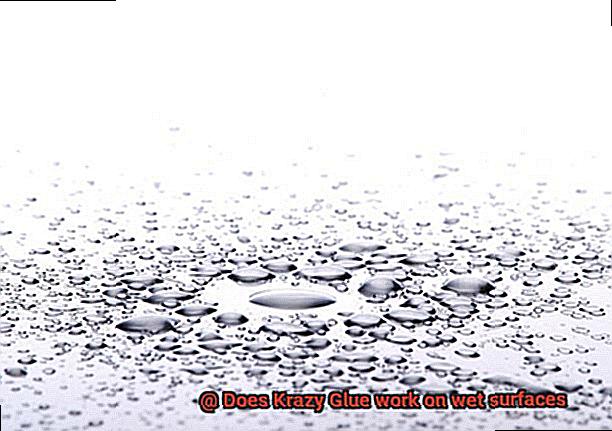
It’s always a good idea to test Krazy Glue on a small, inconspicuous area of the wet surface before applying it to a larger area. This will allow you to see if the glue works effectively on that particular material.
How to Test a Small Area Before Applying Krazy Glue to a Wet Surface
Testing a small area before applying Krazy Glue to a wet surface is crucial to ensure a successful bond. By conducting this test, you can avoid potential mishaps or damage that may occur if the glue does not work well on wet surfaces. It allows you to gauge the effectiveness of Krazy Glue on the specific material you are working with and determine if it will provide the desired results.
Gathering the Materials
To begin the testing process, gather all the necessary materials. You will need a small patch of the wet surface material, a small amount of Krazy Glue, and a clean cloth or paper towel. Having these materials ready beforehand will make the testing process smoother and more efficient.
Cleaning the Surface
Before applying the glue, it is essential to clean the small area you want to test. Use a mild detergent or soap and water to remove any dirt or debris from the surface. Ensure that the area is thoroughly cleaned and free from any contaminants. After cleaning, dry the area completely with a clean cloth or paper towel. A clean surface will provide accurate testing results.
Applying the Glue
Using a toothpick or a small disposable applicator, apply a small amount of Krazy Glue to the cleaned area. It is important to cover the surface with a thin and even layer of glue. Avoid using an excessive amount of glue, as it may lead to excessive bonding and difficulty in removal later on.
Observing the Results
After applying the glue, allow it to dry completely according to the product instructions. This may take a few minutes to several hours, depending on the type and thickness of the glue used. During this time, refrain from touching or disturbing the glued area.
Once the glue has dried, carefully observe the results. Check if it has formed a strong bond with the wet surface material and if it has maintained its adhesion over time. If the bond is strong and secure, it indicates that Krazy Glue can effectively work on wet surfaces. However, if the bond is weak or easily breaks apart, it suggests that Krazy Glue may not be suitable for bonding on wet surfaces.
Considering Alternatives
If the test results indicate that Krazy Glue does not bond effectively on the wet surface material, it is recommended to consider using an alternative adhesive specifically designed for wet surfaces. There are other adhesives available that may provide better bonding capabilities in damp conditions. It is important to choose an adhesive that suits your specific project requirements and follows the manufacturer’s instructions for optimal results.
Different Types of Primers for Bonding to Wet Surfaces
Well, prepare to be amazed, because with the right primer, it’s like witnessing pure magic. Primers are extraordinary concoctions designed to create strong and durable bonds on wet surfaces.
So, let’s take a dive into the enchanting world of different types of primers for bonding to wet surfaces and uncover their secrets.
Moisture-Cured Primers:
Picture these primers as caped crusaders that possess the power to cure in the presence of moisture. Packed with special chemicals that react with water in the air or on the surface itself, they perform miracles by creating super-strong bonds, even in damp conditions. These primers are ideal for those tricky situations where you need to stick things together despite a drizzle or a downpour.
Epoxy Primers:
Epoxy primers are revered for their exceptional adhesion properties. Imagine them as fearless adventurers that fearlessly penetrate wet surfaces and establish an unbreakable bond with the substrate. Popular in construction and marine applications where wet conditions prevail, epoxy primers work wonders even when faced with the challenges posed by moisture.
Primers for Wet Concrete Surfaces:
Bonding wet concrete surfaces can feel like taming a wild beast, but fear not. Enter the realm of primers specifically formulated for this purpose. With their unique blend of chemicals, these primers penetrate the porous concrete surface and forge an unyielding bond, even when it’s damp or saturated. They are the go-to choice for construction projects that demand strong bonds in the face of wet concrete.
General-Purpose Primers:
When versatility is key, general-purpose primers rise to the occasion. Think of them as adaptable chameleons that can handle a variety of surfaces, including wet ones. These water-based primers possess the uncanny ability to be applied directly to wet surfaces. While they may require longer drying times compared to other primers, they still deliver a robust bond once fully cured.
Safety Tips for Working with Adhesives
Working with adhesives can be a sticky situation if not done safely. Whether you’re using Krazy Glue or any other adhesive, it’s important to take precautions to protect yourself and others. In this blog post, we’ll explore the importance of safety when working with adhesives and provide you with some essential tips to follow.
Read and Follow Instructions:
Before diving into your adhesive project, always read and understand the manufacturer’s instructions. These instructions provide important information on how to use the product safely and what precautions to take. Ignoring these instructions could lead to accidents or injuries.
Work in a Well-Ventilated Area:
Adhesives can release fumes that are harmful if inhaled. To ensure your safety, always work in a well-ventilated area. Open windows or use fans to improve air circulation. If you’re working with particularly strong adhesives, consider wearing a respiratory mask for added protection.
Wear Protective Gear:
Protective gear is essential when working with adhesives. Gloves, safety goggles, and even a respiratory mask are examples of personal protective equipment (PPE) that should be worn based on the type of adhesive being used. These simple steps can prevent skin irritation, eye injuries, and respiratory issues.
Keep Adhesives Out of Reach:
Adhesives should always be stored in a secure location away from children and pets. Many adhesives are toxic if ingested and can cause serious harm. So, make sure to keep them out of curious hands or paws by storing them safely.
Clean Up Spills Promptly:
Accidents happen, but it’s crucial to clean up any spills or drips immediately. Leaving adhesive on surfaces can lead to accidental sticking or damage to materials. So, have some cleaning supplies handy to tackle any messes quickly and efficiently.
Proper Disposal:
Adhesive containers should not be thrown in regular trash bins as some may be considered hazardous waste. Check with your local waste management facility for proper disposal instructions. By disposing of adhesives responsibly, you help protect the environment and prevent potential harm.
Alternatives to Krazy Glue for Use on Wet Surfaces
Picture this: you’re knee-deep in a project that requires bonding surfaces, but they’re stubbornly wet or damp. While Krazy Glue is a star adhesive for many situations, it may not be the best option for these tricky conditions. Fear not. There are alternatives out there that have been specifically crafted to conquer the challenges presented by moisture. In this blog post, we’ll dive into these alternatives, guiding you towards the perfect solution for all your wet surface bonding needs.
Epoxy Adhesive:
When it comes to bonding strength and durability, epoxy adhesives reign supreme. These specially formulated warriors can handle wet surfaces like champs, forging a powerful bond even in the face of moisture. Whether you’re fixing a leaky pipe or rescuing a broken piece of furniture, epoxy adhesive is your trusty sidekick.
Marine Adhesive/Sealant:
If you find yourself battling water or harsh environmental conditions, marine adhesive/sealant is your ultimate ally. This adhesive has been battle-tested in boat building and repair, creating an impenetrable seal that laughs in the face of water and other formidable foes.
Silicone Sealants:
For situations that demand water resistance, silicone sealants are your go-to heroes. These flexible and waterproof adhesives adhere like glue to both porous and non-porous materials. Whether you’re sealing a shower enclosure or repairing a leaky roof, silicone sealants have got your back, front, and everything in between.
Specialized Super Glues:
Prepare to be amazed – there are super glues out there specifically designed to thrive in the presence of moisture. These specialized formulas are the perfect alternative to Krazy Glue when working on wet surfaces, ensuring your bond remains unbreakable.
Remember: Surface Preparation is Key.
No matter which alternative adhesive you choose, proper surface preparation is the key to victory. Clean, dry, and pristine surfaces are the battlegrounds for the best results. Rid them of any contaminants or debris before applying the adhesive, and watch as your bond becomes an unyielding force.
QthlA8A8G3s” >
Conclusion
In conclusion, it is evident that Krazy Glue does indeed work on wet surfaces.
This remarkable adhesive defies the odds and proves its effectiveness even in the face of moisture. Whether you’re dealing with a spilled drink or a rainy day mishap, Krazy Glue comes to the rescue, bonding materials together with unmatched strength.
Its unique formula seeps into every nook and cranny, creating a bond that withstands the test of time, regardless of wetness.

